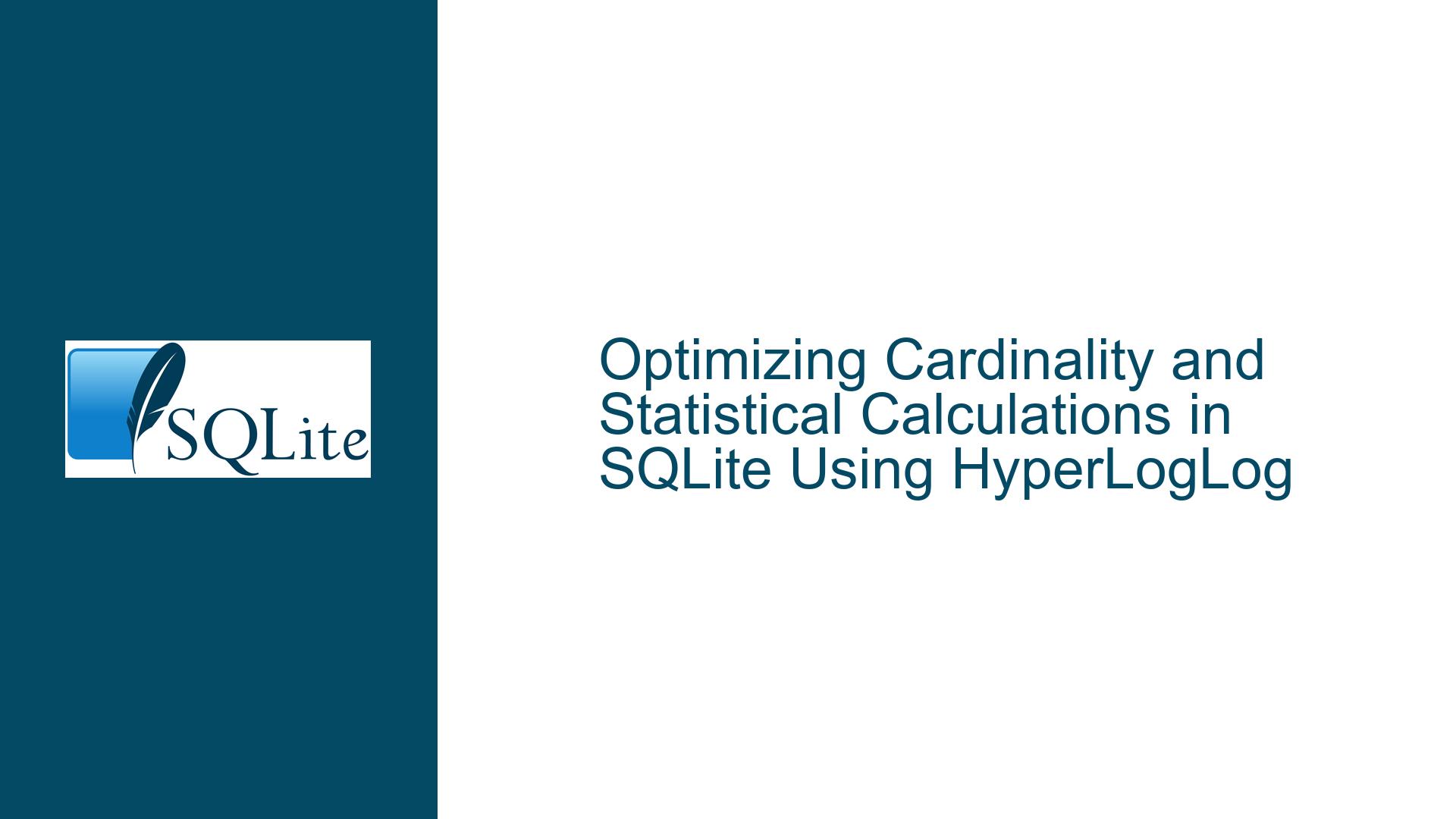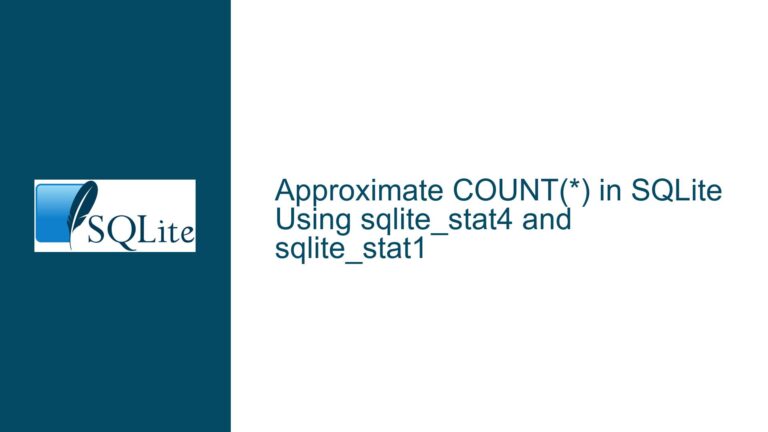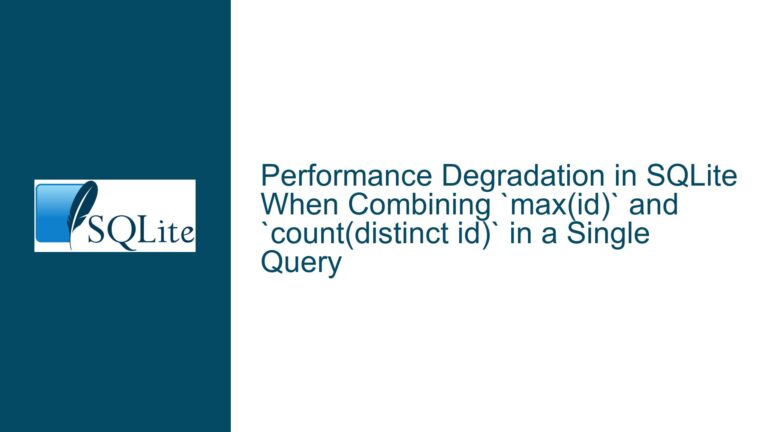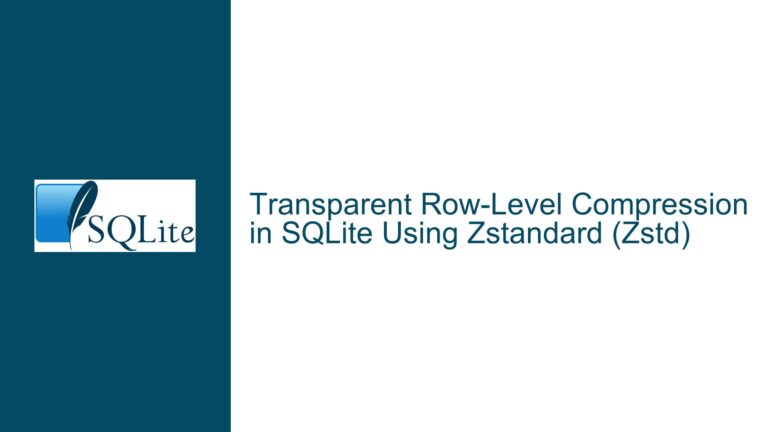Optimizing Cardinality and Statistical Calculations in SQLite Using HyperLogLog
Efficiently Calculating Column Statistics in SQLite with HyperLogLog
SQLite is a powerful, lightweight database engine that excels in many use cases, particularly those requiring embedded or low-overhead solutions. However, when dealing with large datasets, calculating column statistics such as cardinality, percentiles, and null percentages can become computationally expensive. This post explores the challenges of efficiently calculating these statistics, the potential of HyperLogLog as a solution, and detailed steps to implement and troubleshoot such optimizations in SQLite.
Challenges in Calculating Cardinality and Statistical Metrics
Calculating the cardinality of a column—the number of unique values—is a common but resource-intensive operation, especially when dealing with millions of records. The naive approach involves scanning the entire column, building a set of distinct values, and counting them. This process consumes significant memory and computational resources, particularly when the column contains a high number of unique values. Additionally, calculating percentiles for numeric columns and determining the percentage of null values further compounds the computational load.
The primary challenge lies in balancing accuracy and performance. While exact calculations are desirable, they often come at the cost of efficiency. This trade-off becomes particularly pronounced in environments with limited resources, such as embedded systems or applications requiring real-time analytics. HyperLogLog, a probabilistic algorithm, offers a compelling solution by providing approximate cardinality estimates with significantly reduced memory usage.
HyperLogLog as a Solution for Approximate Cardinality
HyperLogLog is an algorithm designed to estimate the cardinality of large datasets with a high degree of accuracy while using minimal memory. It works by hashing each value in the dataset and using the resulting hash values to estimate the number of unique elements. The algorithm’s memory usage is determined by the precision parameter, which controls the trade-off between accuracy and resource consumption.
In the context of SQLite, implementing HyperLogLog as a custom C module or extension function could provide a scalable solution for estimating cardinality. By leveraging HyperLogLog, SQLite users can achieve near-real-time cardinality estimates without the overhead of exact calculations. This approach is particularly beneficial for applications requiring frequent statistical analysis of large datasets, such as data visualization tools or real-time monitoring systems.
Implementing and Troubleshooting HyperLogLog in SQLite
Implementing HyperLogLog in SQLite involves several steps, including integrating the algorithm as a custom function, optimizing its performance, and validating its accuracy. Below, we outline the key considerations and troubleshooting steps for each phase of implementation.
Integrating HyperLogLog as a Custom SQLite Function
The first step in implementing HyperLogLog in SQLite is to create a custom aggregate function. This function will take a column’s values as input, apply the HyperLogLog algorithm, and return an approximate cardinality estimate. The function can be implemented in C for optimal performance and integrated into SQLite using the SQLite C API.
When integrating the function, it is crucial to handle memory allocation and deallocation efficiently to prevent memory leaks. SQLite’s memory management functions, such as sqlite3_malloc and sqlite3_free, should be used to allocate and release memory for the HyperLogLog data structures. Additionally, the function should be designed to handle large datasets gracefully, ensuring that it does not exceed available memory resources.
Optimizing HyperLogLog Performance in SQLite
Once the HyperLogLog function is integrated, the next step is to optimize its performance. This involves tuning the precision parameter to balance accuracy and memory usage. A higher precision value increases the accuracy of the cardinality estimate but also increases memory consumption. Conversely, a lower precision value reduces memory usage but may result in less accurate estimates.
To determine the optimal precision value, it is recommended to conduct performance testing with representative datasets. This testing should measure both the accuracy of the cardinality estimates and the memory usage for different precision values. Based on the results, the precision parameter can be adjusted to achieve the desired balance between accuracy and resource consumption.
Another performance optimization involves minimizing the overhead of function calls. Since HyperLogLog requires processing each value in the column, the function should be designed to handle bulk processing efficiently. This can be achieved by batching values and processing them in chunks, reducing the number of function calls and improving overall performance.
Validating HyperLogLog Accuracy and Handling Edge Cases
After optimizing the HyperLogLog function, it is essential to validate its accuracy and handle potential edge cases. Validation involves comparing the approximate cardinality estimates produced by HyperLogLog with exact cardinality calculations for a range of datasets. This comparison helps identify any systematic biases or inaccuracies in the algorithm’s estimates.
Edge cases to consider include datasets with very high or very low cardinality, datasets with skewed value distributions, and datasets containing null values. For datasets with high cardinality, HyperLogLog should provide accurate estimates with minimal memory usage. For datasets with low cardinality, the algorithm may overestimate the cardinality, so additional checks may be necessary to handle such cases.
Handling null values is another important consideration. Since null values do not contribute to the cardinality of a column, the HyperLogLog function should be designed to skip null values during processing. This ensures that the cardinality estimate accurately reflects the number of unique non-null values in the column.
Troubleshooting Common Issues with HyperLogLog in SQLite
Despite its advantages, implementing HyperLogLog in SQLite can present several challenges. Common issues include memory leaks, inaccurate estimates, and performance bottlenecks. Below, we outline troubleshooting steps for each of these issues.
Memory leaks can occur if the HyperLogLog data structures are not properly deallocated after use. To diagnose and fix memory leaks, it is recommended to use SQLite’s memory debugging tools, such as sqlite3_memory_used and sqlite3_memory_highwater. These tools can help identify memory allocation patterns and pinpoint the source of leaks.
Inaccurate estimates may result from an improperly tuned precision parameter or biases in the HyperLogLog algorithm. To address this issue, it is important to conduct thorough validation testing with diverse datasets. If inaccuracies are detected, the precision parameter should be adjusted, or additional corrections may need to be applied to the algorithm’s output.
Performance bottlenecks can arise from inefficient function implementation or excessive memory usage. To troubleshoot performance issues, it is recommended to profile the HyperLogLog function using SQLite’s profiling tools, such as sqlite3_profile. This profiling can help identify hotspots in the code and guide optimization efforts.
Conclusion
Implementing HyperLogLog in SQLite offers a powerful solution for efficiently calculating column statistics, particularly cardinality estimates, in large datasets. By understanding the challenges, leveraging the algorithm’s strengths, and following best practices for implementation and troubleshooting, SQLite users can achieve significant performance improvements while maintaining acceptable accuracy. This approach not only enhances the scalability of SQLite-based applications but also opens up new possibilities for real-time analytics and data visualization.






